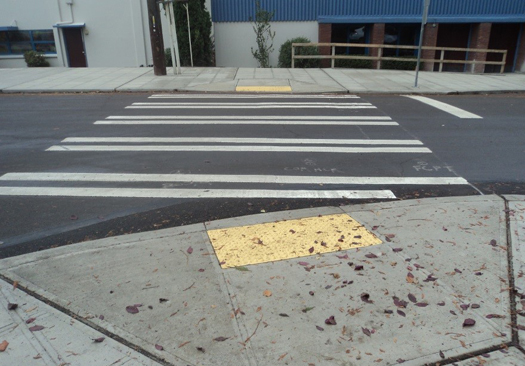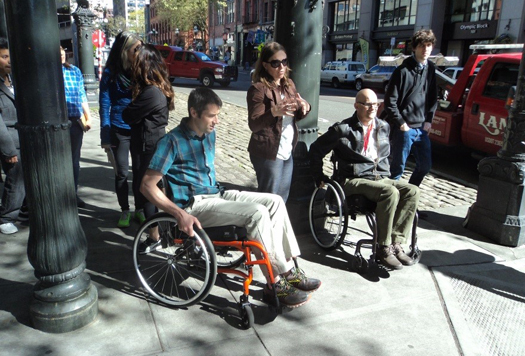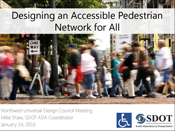A Pedestrian Network Accessible to All

When we think about our sidewalks and street crossings getting us where we want or need to be, presumably we would all like those routes to be safe, comfortable, and easy to use.
The Seattle Department of Transportation (SDOT) strives to design, build, and maintain an accessible pedestrian network that is usable to all pedestrians. This includes access for those with disabilities, the elderly, parents with strollers, and even delivery drivers that need to use the sidewalk to access facilities. SDOT works to provide this accessible pedestrian network—including sidewalks, curb ramps, street crossings, and any other pedestrian facility—that is usable for pedestrians with a wide and varying range of abilities.
When it comes to sidewalk slope, there isn’t much that SDOT can do to flatten the hills in Seattle, but the goal is to provide a minimal slope from side-to-side while still allowing for water to drain off the sidewalk. A steep slope from side-to-side can make sidewalk use challenging for all pedestrians, particularly those using wheelchairs or other mobility aids.

Steep side-to-side slopes can be difficult to negotiate
SDOT strives to provide and maintain sidewalks that are free of dramatic level changes and bumps that can make use difficult or impossible for wheeled devices. Mature trees and tree roots below sidewalks can make this a major challenge in Seattle.
It is also important to keep the sidewalk wide enough and clear of vegetation and other obstacles as well as maintaining adequate clear headroom above, which can be critical for taller pedestrians with vision impairments who may not be able to see low-hanging tree branches or other obstructions.
One of the most important elements in an accessible pedestrian network is a curb ramp, which allows for a wheeled device to travel down a ramp from the sidewalk into a street crossing. While this particular feature is important, what many do not know is the level of complexity that is involved in the design and construction of curb ramps in an existing built environment that will be usable to all.
Seattle’s biggest challenges are its hills and topography, but it is also important to note that curb ramps compete for space in a generally crowded area of the sidewalk. There are utility structures in the sidewalk, light and utility poles, fire hydrants, and many other potential obstructions. Sometimes the sidewalk is just not wide enough to accommodate the preferred ramp design. Other times the sidewalk may be a part of a larger structure, like a bridge or overpass, and modifications to the structure are not feasible. Challenges are abundant not only for the engineers who design these ramps but for the construction professionals that build them out in the field.

Typical curb ramp
Other considerations when providing an accessible pedestrian network may include sidewalks and curb ramps that align well with street crossings, adequate time available to cross the street, providing audible or tactile crossing information to pedestrians that cannot see or may have visual impairments, and good access from the sidewalk to transit shelters or facilities.
With all the construction going on in Seattle, it’s also important to provide good access around construction sites when the sidewalks are impacted or even closed.
At times the engineers that design these facilities are able to learn directly from groups or individuals that provide feedback on what may be a challenge when negotiating a public way; in these cases, SDOT may go beyond the standard design criteria to help provide better access for all. SDOT encourages community engagement so there is a good awareness of the needs of ALL pedestrians.

SDOT staff participated in a mobility simulation using a wheelchair
Contributor Michael Shaw is the ADA coordinator at Seattle Department of Transportation. If you have questions about accessibility within the Seattle public right-of-way, contact Mike at Michael.Shaw@Seattle.gov.
All photos courtesy of SDOT.
 Seattle Department of Transportation ADA coordinator Mike Shaw and design and construction engineers John Ricardi and Eugene Pike discussed challenges and solutions in developing a pedestrian network that works for all at a Northwest Universal Design Council event in January 2016. For more information, see their Powerpoint slides (click here).
Seattle Department of Transportation ADA coordinator Mike Shaw and design and construction engineers John Ricardi and Eugene Pike discussed challenges and solutions in developing a pedestrian network that works for all at a Northwest Universal Design Council event in January 2016. For more information, see their Powerpoint slides (click here).
![AgeWise King County [logo]](https://www.agewisekingcounty.org/wp-content/themes/agewisekingcounty/images/logo.png)